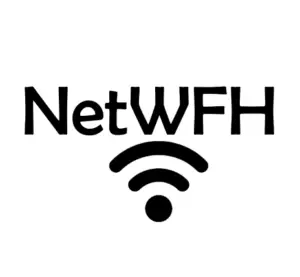This post contains affiliate links.
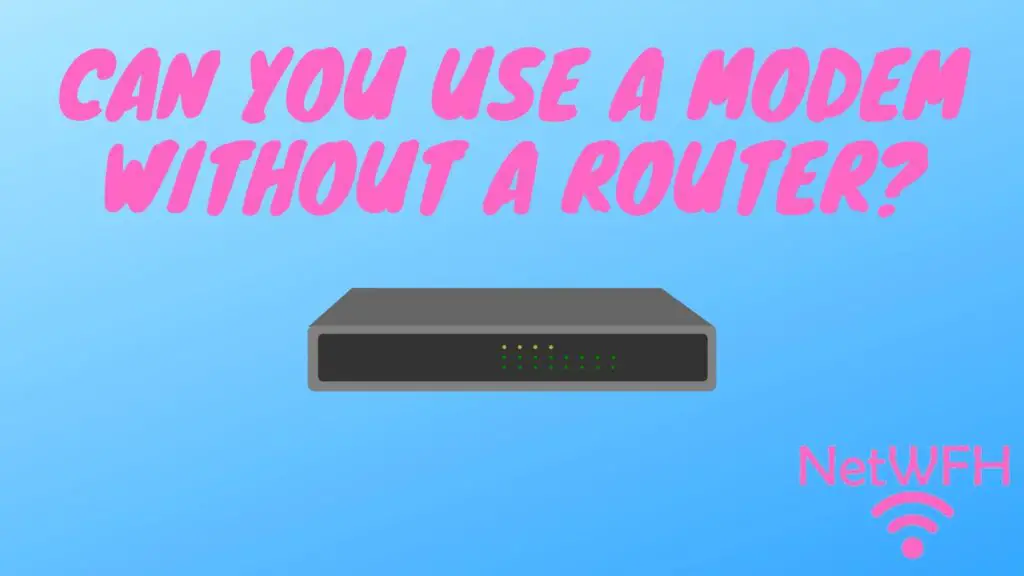
Let me set the scene.
You’re getting ready to set up your home internet. You’re researching the different types of equipment you need for a blazing internet experience.
At this point you come to a roadblock.
“What’s the difference between a modem and router?”, you ask.
“Do I need both of them to access the internet? Or will a modem give me all I need?”
Before we go any further, I want you to understand that these types of questions pop up all the time. Especially when people are setting up their home internet for the first time.
The good news is, you’ve come to the right place for answers to all of your questions.
So let’s talk about your modem.
A modem should not be used on a home network without a router. Doing so would present significant cybersecurity risk to the network. Using a modem with a router allows multiple devices on a network to share an internet connection, and provides additional security to the network as well.
In this post I’ll explain why you shouldn’t use a modem without a router, the benefits that a router provides to your home internet, and what your home network should look like.
Let’s get started.
Why You Shouldn’t Use a Modem Without a Router
There are two main reasons why you shouldn’t use a modem without a router in your home network.
Modems and Routers Do Different Things in a Home Network
To put it simply, modems and routers are designed to do different things.
With that said, they both have important jobs when it comes to your internet connection. That’s why you need both of them for your internet to work properly.
By explaining what the jobs of your modem and router are, you’ll see why one shouldn’t be used without the other.
A Modem’s Responsibilities in a Home Network
The job of a modem is to provide your home with a connection to the internet.
Without a modem, you wouldn’t be able to access the internet in the first place. This is why you can’t use a router without a modem if you want to access the internet.
Once you pay for an internet plan from your internet service provider (ISP), you can use your modem to establish a connection with your ISP.
Your modem basically serves as a connection point between your home network and the internet. Think of it as a highway that your devices use to send (and receive) data to the internet.
One important thing to note here is that your modem doesn’t send any of the data from your devices to the internet. That’s the router’s job.
A Router’s Responsibilities in a Home Network
Your router’s job is to use the internet connection that your modem establishes to communicate with the internet.
It’s responsible for sending all the requests from your devices to the internet. When you want to access a website from your computer, the website request is sent from your computer to your router.
Your router then passes this request over the connection established by your modem to the internet.
The requested website is then returned from the internet to your router. Your router then forwards the requested website to the device that requested it.
For a visual, here’s a diagram showing how an internet request travels from your home network to the internet and back.

Without a modem to pass internet requests over, a router would be useless when it comes to internet connections.
Hopefully you can see why your modem and router are important, and why both devices are needed for an internet connection. Using a router has additional benefits as well.
Modem’s Don’t Provide Any Security to Devices on the Network
The other main reason why you shouldn’t use a modem without a router is because it isn’t safe to do so.
If you were to plug your computer directly into your modem without a router in between them, your computer would be exposed to the internet with very little protection.
You’d be a ripe target for all the hackers and malicious actors on the internet. This is because there’s nothing between your device and the internet that can filter out all the bad requests and hacking attempts targeted at your device.
Thankfully, when you include a router in your home network, your devices are much safer.
Not many people are aware of this, but your routers actually have security features built into them. They’re invisible to the user because they work in the background automatically.
Let’s take a quick look at the main security feature provided by routers.
Routers Provide a Network Address Translation Firewall
Routers protect the internet devices on your network with what’s called a Network Address Translation (NAT) firewall.
A NAT firewall is a built-in feature that comes with your router and works automatically. You don’t need to change any settings for it to work.
Without getting too technical here, the network address translation firewall works because of the fact that routers have two IP addresses: one for your internal home network and one for the external internet.
For any hackers or bad actors that try to send bad requests to your devices, they can only see the external public IP address of your router. They can’t see the internal IP addresses of the devices on your home network.
As a result, your router knows only to accept data that was requested by the internal IP addresses of the devices on your network. If it receives any data from the internet that wasn’t requested by one of your devices, your router knows to get rid of it.

In this sense, the NAT firewall serves as a filter for your devices. It ensures that your devices only receive the information they requested.
This is a level of protection that’s not provided if you plug a computer directly into a modem. Your device will receive all the bad requests that are sent to it because there’s no NAT firewall in place to filter them out.
The Benefits of Having a Router in Your Home Network
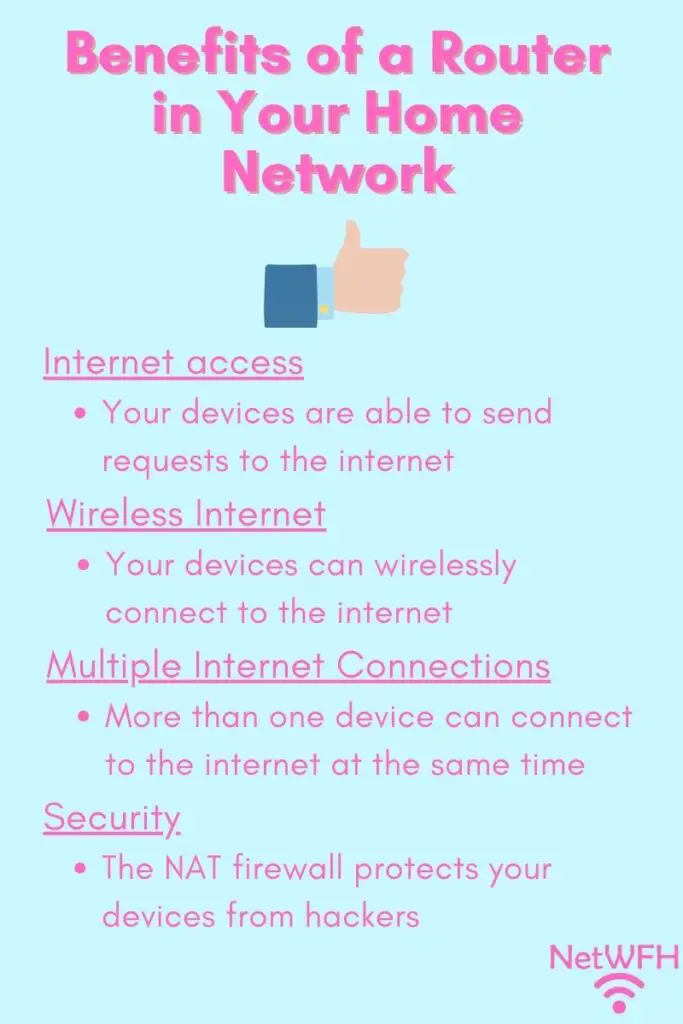
Ok so your router provides security to your devices and allows for them to communicate with the internet.
That sounds like a convincing argument why you should have a router in your home network.
In case you need more convincing, there are additional benefits that a router provides to your home network that you should be aware of as well.
Let’s take a look at these additional benefits.
A Router Allows for Multiple Internet Connections at the Same Time
One important feature of routers is that they allow multiple devices to use the internet at the same time.
If you only had a modem and you didn’t have a router in your home environment, you’d only be able to connect one device to the internet at a time.
Why’s that the case?
That’s because modems only have one ethernet port.
As an example, here’s what the back of my modem looks like.
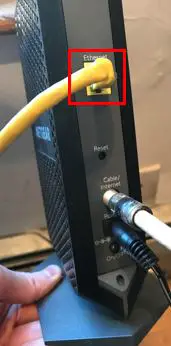
As we discussed, there are obviously other reasons why you shouldn’t use a modem without a router, but could you imagine only being able to connect one device to the internet at once?
The majority of households today have more than ten devices connected to the internet at a given time.
Just think about having to connect a device to your modem every time you wanted to use it on the internet. That would be a miserable experience.
Routers fix this problem because they have multiple ethernet ports you can plug in to.
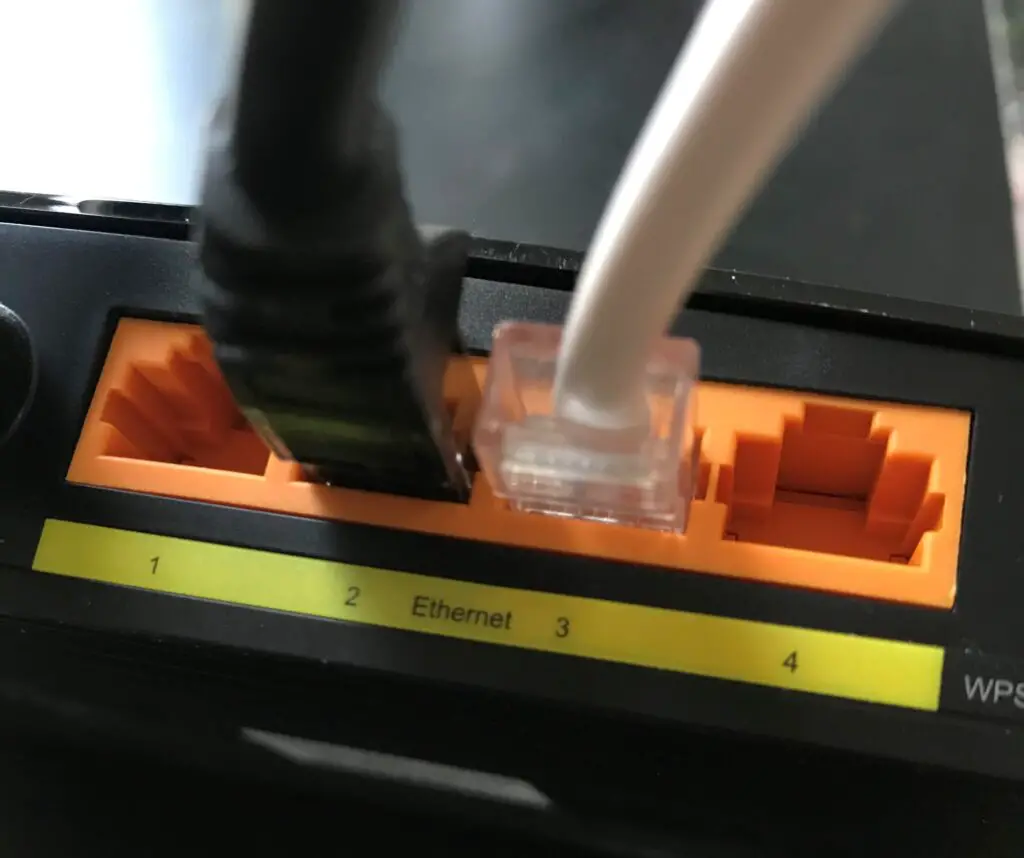
As you can see, my router has four ethernet ports. That means I can have up to four devices connected to my router with a wired connection. I can have even more devices wired to my router if I use an ethernet switch.
Those ethernet ports are just for the wired connections I want.
Did I mention that routers also allow for wireless connections to the internet as well?
A Router Provides Wireless Internet Connectivity
Routers are the reason you have WiFi in your home.
Routers have antennas on them that broadcast your wireless network signal through the air. Your devices can connect to this wireless signal and use it to send messages to your router. Your router will then send these messages to the intended destination. This is how your devices wirelessly connect to the internet.
Without WiFi in your home, you’d have to manually plug in all your internet devices to your modem for them to have internet access.
As we discussed earlier, you can only connect one device at a time to your modem.
Imagine how long some of those ethernet cables would have to be if you didn’t have a wireless internet connection. Your home would look like a rats nest.
On top of that, having to physically plug in a device every time you wanted to use it on the internet is like having to get up and turn a knob every time you want to change the channel of your TV. Not fun.
The good news is you don’t have to worry about that. With a modem and router in your home, you can quickly and easily connect as many devices as you want to the internet at the same time.
Hopefully you appreciate how your router makes life on the internet so much easier.
How to Connect Your Modem and Router
By now you should be convinced that a modem and router are both required for a safe and easy internet experience.
So what should your home network look like? How should your modem and router be connected?
Thankfully, this is pretty straightforward.
How to Connect the Modem to the ISP
First things first. Your modem should be connected to the internet that’s provided by your internet service provider.
There’s usually a port on the back of your modem labeled for your internet connection. This port will look different based upon the type of internet connection you have.
There are multiple types of internet connections available to you. In my case, I have cable internet.
As a result, this is what the internet connection on the back of my modem looks like:
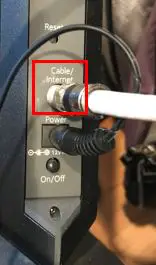
Most modems will look like this because cable internet is the most common type of internet connection.
The cable that’s connected to this port on your modem comes from outside your home and is connected to your ISP on the other end. Your ISP will provide this connection to your house once you have an internet plan in place.
How to Connect the Modem and Router
The only other connection you’ll have to make from your modem (aside from the power cord) is the connection to your router.
Your modem and router will be connected by an ethernet cable if they’re separate devices. The ethernet cable to connect these two devices usually comes with the router when you buy one.
It should be pretty easy to identify what port the ethernet cable connects to on your modem and router.
Let’s start with your modem.
On the back of your modem, there should be a port labeled “Ethernet”. Unsurprisingly, this is where the ethernet cable goes.
It should look something like this:

On your router, there’s a similar port that should be labeled “Internet”.
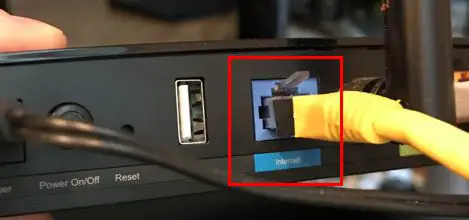
This is where the other end of the ethernet cable is connected.
And that’s it. That’s all you need to do to set up your network properly with a modem and router.
Network Diagrams of What a Home Network Should Look Like
To help visualize what your home network should look like if your modem and router are separate devices, this diagram may help:
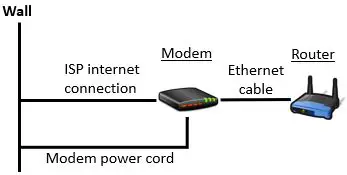
To make things easier on yourself, you can buy a modem and router combination device. If you have a combination device you only need to connect the internet cable (and power cord) for it to work properly.
With a modem and router combination device this is what your network should look like:
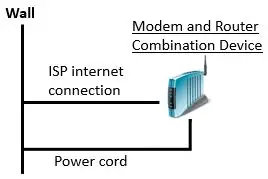
See, it’s a little easier than having separate modem and router devices.
Once you have your modem and router set up properly, you can connect your devices to the internet either wirelessly or by connecting them to your router with an ethernet cable.
Should You Ever Plug Your Computer Into Your Modem?
After spending this entire post explaining that you should never plug your computer directly into your modem, I must say I have a confession to make.
There’s actually one case where you need to plug your computer into your modem.
When you’re first setting up your modem’s connection to your internet service provider, you’ll have to plug your computer directly into your modem.
Upon doing so, you can register your modem with your ISP. This step is required to establish an internet connection with your service provider. You won’t be able to get internet access without doing this.
The specific steps you need to follow to activate your modem will be detailed in your modem’s user manual.
As a note, you’ll have to follow these steps every time you get a new modem for your home network.
To hammer this point home, this is the only time your computer should be plugged directly into your modem. You should never try to browse the internet without a router between your computer and your modem.
If the only time you plug your computer into your modem is when you’re setting up your modem, you’ll be in good shape.
Wrap Up
There you have it folks.
Hopefully it’s crystal clear that you should always be using both a modem and router if you want to use the internet.
If you have any questions about this information or you want to share some tips about your modem and router setup, drop a line in the comments section below.
If you found this information useful, check out some similar posts I have previously written:
Can I Use a Router Without a Modem?
How Many IP Addresses Should a Router Have?
